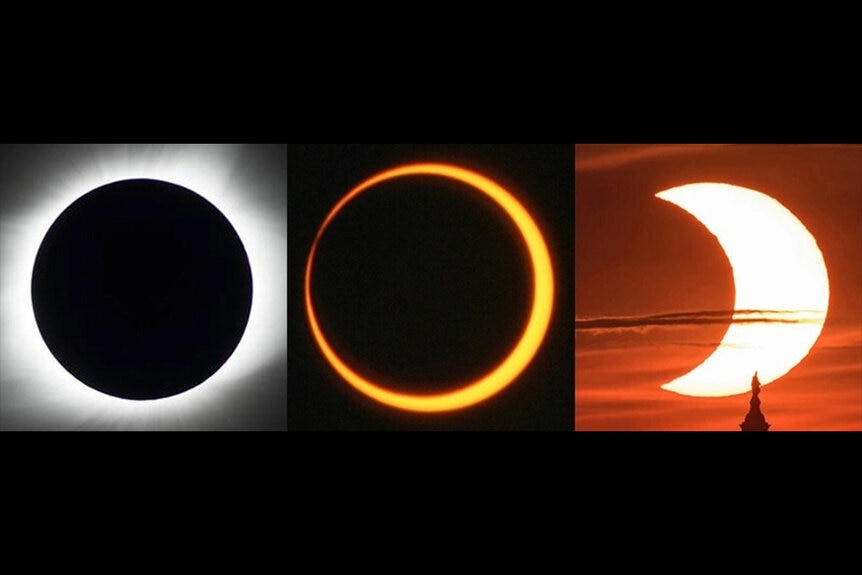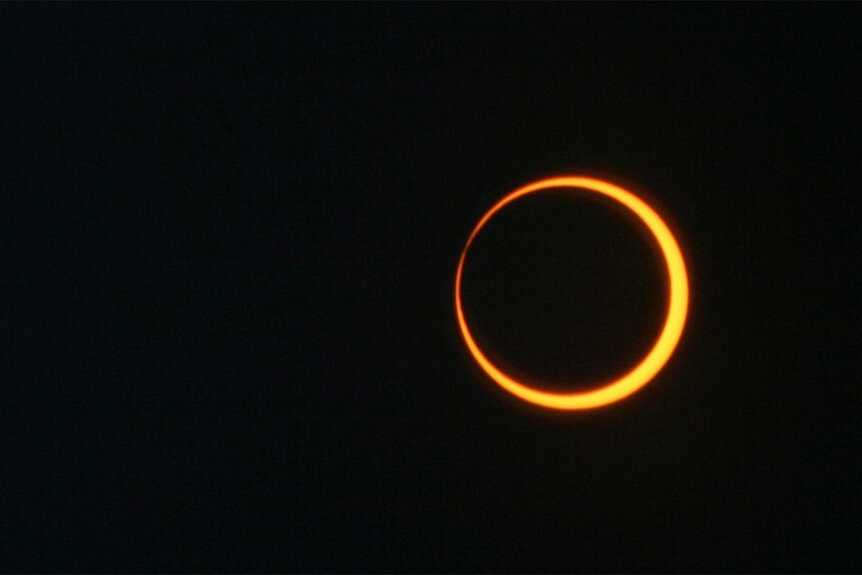Create a free profile to get unlimited access to exclusive videos, sweepstakes, and more!
Everything You Need to Know About the 2023 Annular Solar Eclipse
October's annular solar eclipse will be visible from parts of North, Central, and South America. Here's what you need to know.

In the science fiction horror classic Pitch Black (streaming now on SYFY!), the spaceship Hunter-Gratzner crash lands on the mysterious planet M6-117. The survivors of the crash, including the wild-eyed prisoner Richard B. Riddick (Vin Diesel) find the remains of an abandoned scientific research station and a bloodthirsty species of monsters who only come out at night.
Fortunately, M6-117 is perched in a triple star system, beneath the nearly endless light of three suns. Only a rare celestial event, involving multiple large nearby planets, ever blocks out all three stars at the same time. That’s when the monsters come.
RELATED: Incredible Video of a Solar Eclipse… From the Surface of Mars!
Eclipses on Earth are much more common than on M6-117, although still rare. Lucky for us, they are opportunities to marvel at the wonder of the cosmos without any ravenous underground beasts. And your next opportunity to see one is coming up October 14, 2023.
The Annular Solar Eclipse of October 2023
There are between three and five solar eclipses every calendar year, depending on how the orbits of the Earth and Moon line up. Unlike M6-117, where a bizarre set of circumstances completely blocks out all three stars, eclipses on Earth only block out the Sun along the thin line of the Moon’s shadow.
Moreover, there are three different basic types of eclipses (and one super rare hybrid kind), all of which depend on how the Moon’s shadow falls across the planet. The first and most famous is the total solar eclipse, which is more or less what it sounds like. During a total solar eclipse, the Moon completely blocks out the Sun, leaving only its corona visible as a diffuse halo around the Moon.
We get total solar eclipses through a happy coincidence of our solar system’s setup. The Moon has a diameter roughly 400 times smaller than the Sun and it is, on average, 400 times closer to us, which means they both have the same apparent size in the sky. When things line up nicely, the Moon perfectly blocks out the Sun in a total solar eclipse.
RELATED: The Moon's shadow shapeshifts during rare hybrid solar eclipse
Next are partial eclipses. These happen when the orbits don’t line up quite right. Instead of blocking out the Sun completely, the Moon dips into the area of the Sun, creating a crescent, then dips out again. The last common type of eclipse is an annular solar eclipse, and it’s what you’ll see on October 14.
We get annular eclipses because the Moon doesn’t orbit the Earth in a perfect circle. Instead, the orbit is ovular, with certain points being slightly farther away than others. During an annular eclipse, the Moon is at or near its farthest point from the Earth. As a result, it has a smaller apparent size in the sky and is too small to fully obscure the Sun when it passes in front of it.
Instead, the Moon will look like a large drifting pupil moving across the eye of the Sun. Importantly, because the Moon never totally blocks the Sun, there is no totality and no safe time to look at the eclipse without protective eyewear.
Eye Safety During the October 2023 Annular Solar Eclipse
Solar eclipses are among the most beautiful and wondrous celestial events visible from our planet. Moreover, total solar eclipses are the only time it's safe to look at the Sun (obscured as it is) with the unprotected eye. Astronaut Mike Massimino has dedicated his life to the exploration of space and, later, educating the public on how space exploration and astronomical events impact us here on Earth.
“I have spent 571 hours and 47 minutes in space, and it gave me a deep sense of respect for the solar system and our home planet. While we know the Moon, Sun and stars are out there, we often overlook the relationship they all have," Massimino told SYFY WIRE. "Solar phenomena, such as an eclipse, reminds us that we are a part of the universe. The concern is that looking directly at the Sun can cause damage to the eyes, whether on Earth or in space. My space suit relied on special visors that shielded us from the Sun’s intense brightness during spacewalks. Similarly, during an eclipse, viewers can use solar eclipse glasses manufactured with ISO 12312-2 standard to shield their eyes from potential damage."
Massimino works with Prevent Blindness, an organization dedicated to the preservation of sight and protection against preventable blindness. The organization's latest program, Eclipse + Your Eyes, is focused on preventing vision damage during the eclipse by providing eclipse viewing glasses manufactured with ISO 12312-2 standard, to keep you safe while eclipse watching.
During a partial or annular solar eclipse, the Moon blocks enough of the Sun that the overall brightness decreases. As a result, your eyes drop their defenses allowing excess heat and light into your tissues. Just a few seconds of looking at an incomplete eclipse is enough to cause permanent damage, even if you don't sense that damage at the time. That's why wearing eclipse glasses at all times (except during the totality of a total solar eclipse) is crucial to your enjoyment of the event and your long-term health.
“A solar eclipse is a way for people on Earth to experience a piece of that beauty. Through my collaboration with Prevent Blindness, we’re helping to give people the opportunity to view the eclipse by equipping them with the safety glasses they need to safely enjoy it. A short duration of exposure, as little as a few seconds of looking directly at the sun during an eclipse, can cause damage to the cells in the retina, the layer of the eye that captures and transmits what you see to your brain. Everyone should have the chance to experience a solar eclipse, but they need to do it safely with the proper eye protection.”
Where to See the 2023 Annular Solar Eclipse
While the upcoming annular solar eclipse won’t offer totality, it will still be a beautiful celestial sight, worth seeking out if you are in or near the path. You’ll be able to see the so-called ring of fire surrounding the Moon from parts of North, Central, and South America.
The eclipse will start at the northwestern tip of North America and travel southeast toward the Atlantic. It will first be visible from Oregon, before traveling in a line across North America to Texas. Along the way, it will pass over parts of California, Nevada, Utah, Arizona, Colorado, and New Mexico. If you’re in North America, the eclipse will start at 9:13 a.m. PT in Oregon and end at 12:03 p.m. CT in Texas.
RELATED: World’s oldest solar eclipse footage reappears, and it look like a real-life Melies movie
Next, it will cut across Central and South America, visiting parts of Mexico, Belize, Honduras, Panama, Colombia, and Brazil. Wherever you’re watching, the entire eclipse, from the first hint of the Moon’s shadow until the end, will last a little more than two hours.
If you miss the upcoming annular eclipse, you’ll have an opportunity to see a total solar eclipse across parts of North and Central America on April 8, 2024.
Get your eclipse preparations in order with Pitch Black, streaming now on SYFY!
Originally published Aug 29, 2023.




























